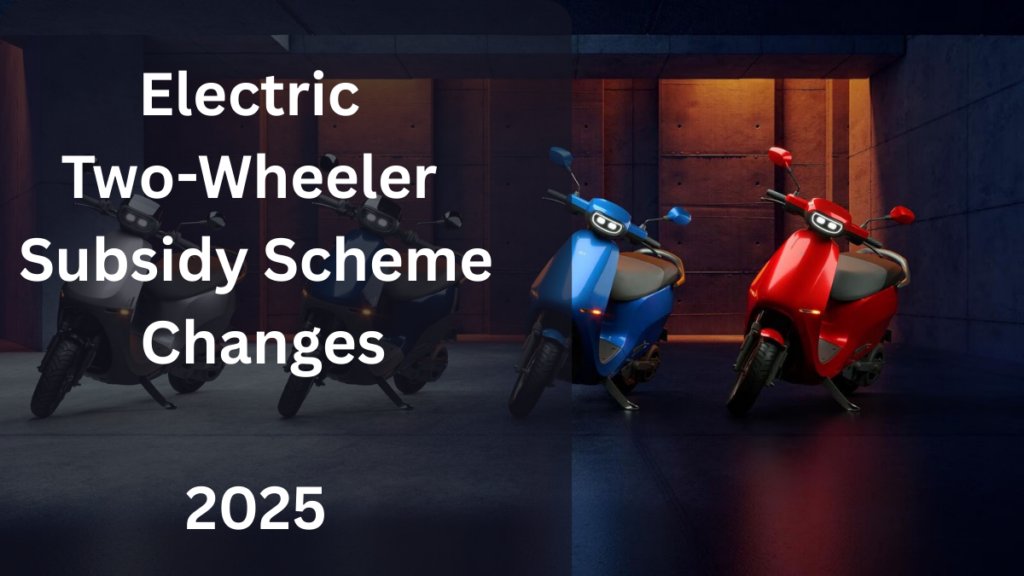As the electric vehicle (EV) movement accelerates across India, 2025 is expected to bring significant changes to the subsidy structure for electric two-wheelers. If you’re planning to buy an electric scooter or motorcycle, here’s everything you need to know about the EV two-wheeler subsidy India 2025, including updates from the anticipated FAME 3 India scheme.

Why Are Electric Two-Wheeler Subsidies Changing in 2025?
The Indian government has been incentivizing EV adoption through initiatives like FAME I and FAME II. With the upcoming launch of FAME 3 India, the policy direction is evolving to focus more on:
-
Reducing reliance on fossil fuels
-
Lowering greenhouse gas emissions
-
Encouraging domestic manufacturing of EV components
-
Making EVs economically viable for middle-class Indian buyers
Key Electric Scooter Subsidy Changes in 2025
With the FAME 3 India policy expected to take effect in April 2025, here are some of the key electric scooter subsidy changes:
| Change | Details |
|---|---|
| Reduced Subsidy Amount | Per vehicle subsidy may decrease from ₹15,000/kWh to ₹10,000/kWh |
| Stricter Eligibility Criteria | Only models with a certain level of local manufacturing may qualify |
| Cap on Maximum Subsidy | The overall subsidy per vehicle could be limited to ₹15,000–₹20,000 |
| Shift in Central Support | Greater role expected from state-level subsidies |
| Battery-Based Incentives | Subsidies may depend on battery size and efficiency standards |
What Buyers Should Consider in 2025
If you’re planning to purchase an electric two-wheeler next year, keep these points in mind:
-
Time Your Purchase: Consider buying early in 2025 to make use of any leftover benefits under FAME 2.
-
Research Manufacturer Compliance: Only scooters that meet the new localization norms will qualify for subsidies.
-
Prepare for Price Adjustments: The reduced subsidy might increase upfront costs by ₹10,000–₹15,000.
-
Look Into State Programs: Some states like Maharashtra, Delhi, and Tamil Nadu may offer additional incentives alongside the central scheme.
How Will FAME 3 India Differ from FAME 2?
Here’s a quick comparison to help you understand how the new scheme might differ:
| Feature | FAME 2 India | FAME 3 India (Expected) |
|---|---|---|
| Subsidy per kWh | ₹15,000 | ₹10,000 |
| Local Manufacturing Requirement | Partial | Mandatory |
| Budget Allocation | ₹10,000 Cr (approx) | ₹5,000–₹8,000 Cr (estimated) |
| Focus | Adoption and affordability | Quality, efficiency, and localization |
| Duration | 2019–2024 | 2025–2029 (proposed) |
The upcoming EV two-wheeler subsidy India 2025 will place more weight on innovation and local sourcing, creating a sustainable and competitive domestic EV ecosystem.
Benefits of Buying an EV in 2025 Despite Lower Subsidies
Even with subsidy cuts, electric two-wheelers remain an attractive choice for Indian consumers. Here’s why:
-
Extremely low running cost (as low as ₹0.25/km)
-
Minimal maintenance expenses
-
Eco-friendly and silent operation
-
Financing options and green loans available
-
Access to special zones, tax exemptions, and toll waivers in some cities
FAQs
1. Will I still get a subsidy on an electric scooter in 2025?
Yes, you will still get a subsidy, but the amount will be lower under FAME 3 India. The new scheme emphasizes quality and localization. Some state governments may offer additional support.
2. When is FAME 3 expected to launch?
The FAME 3 India policy is expected to roll out in April 2025, once FAME 2 concludes at the end of March 2025.
3. Which scooters will qualify for the EV subsidy in 2025?
Only electric two-wheelers that meet the new guidelines on local manufacturing, performance, and battery capacity will be eligible for the EV two-wheeler subsidy India 2025.
4. Can I combine state and central subsidies in 2025?
Yes. Buyers can combine state-specific incentives with the central FAME 3 India subsidy, depending on the region and the manufacturer’s compliance with eligibility rules.
Final Thoughts
The upcoming electric scooter subsidy changes in 2025 represent a pivotal shift in India’s EV policy landscape. The government is moving from generous incentives to performance-based support, encouraging both innovation and local value creation. Even with a slightly lower subsidy, the benefits of owning an electric two-wheeler—cost savings, convenience, and sustainability—remain compelling.
If you’re considering making the switch, now is a smart time to research your options and make an informed choice before the EV two-wheeler subsidy India 2025 comes into full effect.
Click here to learn more
